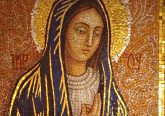The Sign of the Cross
What is the origin and meaning of the Sign of the Cross?
The holiest of signs is the Sign of the Cross. As Catholics, we make it so often that perhaps we take it for granted. It is a profound and powerful act that invokes the Trinity, Jesus’ crucifixion, and the promise of salvation.
The Sign goes back to the Church’s earliest days, likely to apostolic times. It quickly spread as a practice to accompany prayer everywhere there were followers of Christ — whether in the Middle East, North Africa, Asia or Europe. At a time when most were illiterate, Christians embraced the Sign of the Cross readily. It required no particular possessions, knowledge or skill — only faith.
The practice of the Sign began with marking one’s forehead and, later, making a small sign on the lips and the forehead (as is done during Mass before the Gospel is read). Eventually, it became a larger gesture that was more visible.
THE SIGN’S MEANING
The Sign communicates belief in the Trinity, not just the words spoken but also the form of the action. The Sign begins at the forehead by invoking the Father, the first person of the Trinity, then moves to the chest, to show how the Son came down from the Father and took flesh in the Blessed Virgin Mary’s womb. Finally, a sign made between the shoulders shows how the Holy Spirit proceeds from the Father and the Son.
The Sign represents salvation through Jesus. On the cross, Christ conquered sin and death and redeemed humanity. As the spiritual writer Romano Guardian wrote, “By the cross, He sanctifies man to the last shred and fiber of his being.” We make the Sign as we begin any prayer to remind ourselves to whom we are praying. And we similarly conclude prayer in the same way, invoking God to remain with us, to be our strength and protection.
THE SIGN AS SACRAMENTAL
The Sign of the Cross is a “sacramental” — like holy water or the rosary. Sacramentals are sacred signs that resemble the sacraments and prepare us for the sacraments. The Sign of the Cross has a special connection to baptism, the sacrament by which we are claimed for Christ. At baptism, the Sign is made by the sacrament’s minister and (in most cases) parents and godparents.
In the first centuries, the Sign was described as a ritual action and a weapon in spiritual battle. The writings of Hippolytus of Rome in the third century advise Christians: “If you are tempted to sin, seal your foreheads reverently with the Sign of the Passion. It will render the devil powerless, provided that you do it with faith, not to be seen by men, but by presenting it with skill like a shield.”
Later, it became a way to call down God’s blessing on people, places and things (like food). By signing them with the cross, they are claimed for Christ, and evil is commanded to depart.
A PUBLIC WITNESS
Making the Sign of the Cross is an opportunity to witness to the Christian faith publicly. While performing the action quickly or discreetly may be tempting, especially in public, we are reminded that this is one of the clearest and oldest indicators of belief in Christ. As a visible sign of faith, it is intended to remind us of and communicate to others Christ’s victory over sin and death and His promise of eternal life.
 Father David Endres is professor of Church history and historical theology at Mount St. Mary’s Seminary & School of Theology.
Father David Endres is professor of Church history and historical theology at Mount St. Mary’s Seminary & School of Theology.
This article appeared in the January 2024 edition of The Catholic Telegraph Magazine. For your complimentary subscription, click here.













